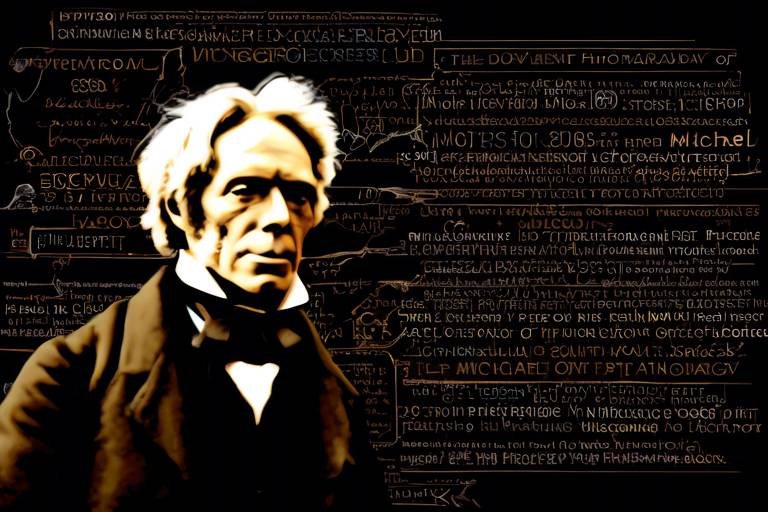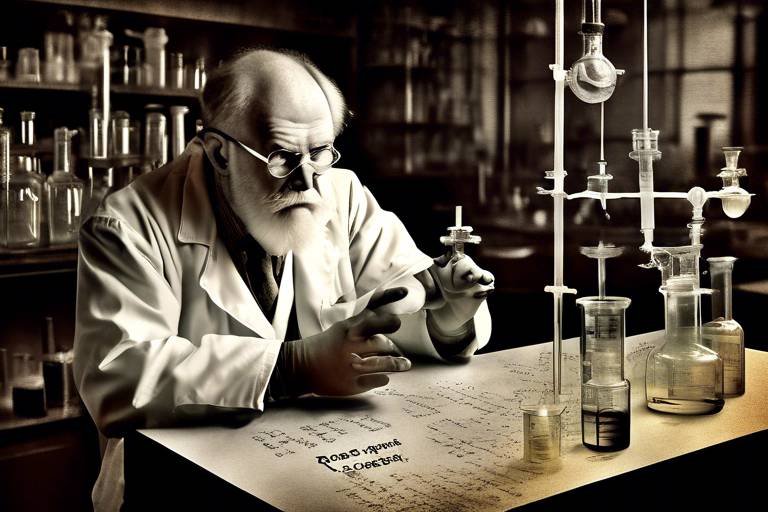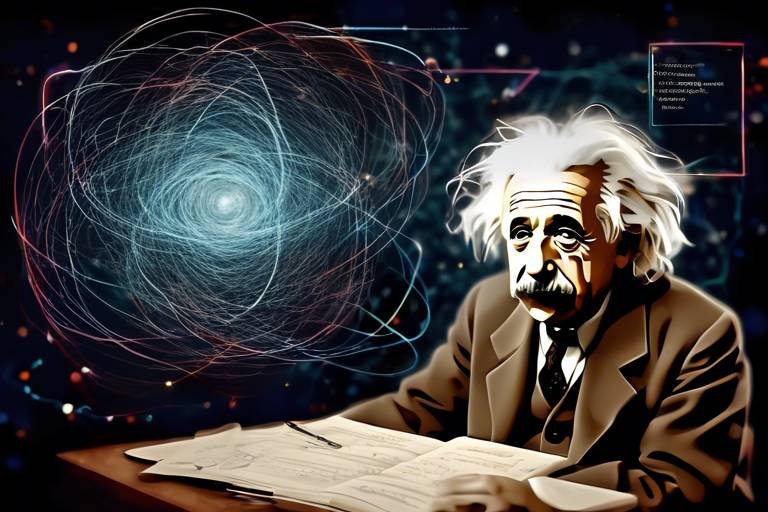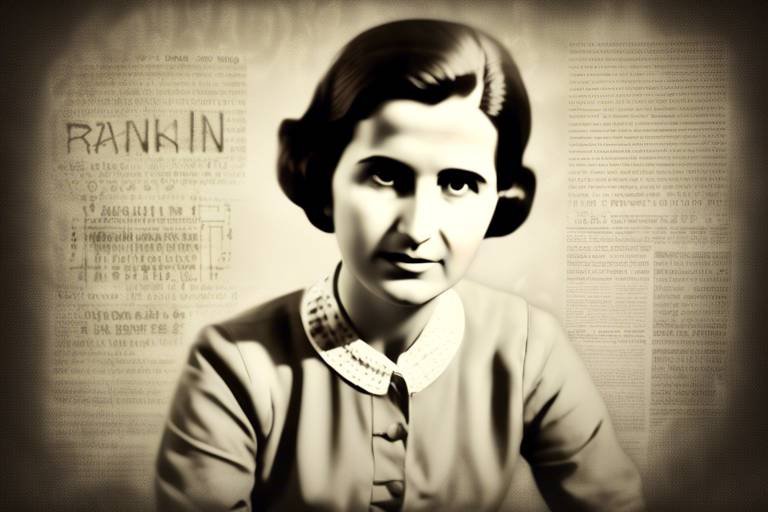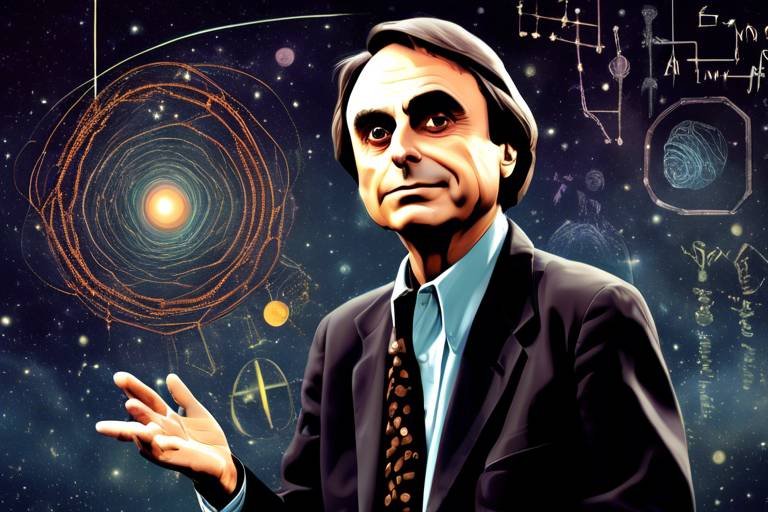The Discoveries of Michael Faraday in Electromagnetism
When we think about the foundations of electromagnetism, one name stands out: Michael Faraday. His groundbreaking discoveries not only transformed our understanding of electricity and magnetism but also paved the way for the technological advancements we enjoy today. Faraday was a man of humble beginnings who, through sheer curiosity and relentless experimentation, unlocked the secrets of electromagnetism. His work is a testament to the power of inquiry and innovation, and it continues to resonate in the fields of physics and electrical engineering.
Faraday's journey into the world of electromagnetism began with his fascination for science, which was fueled by his role as a laboratory assistant to Sir Humphry Davy. It was here that he started to experiment with electricity and magnetism, leading him to formulate some of the most important principles in these fields. Imagine a world without electricity; a world where the simple act of flipping a switch would yield no light. Faraday's discoveries made that world a reality, enabling the development of electric power generation, motors, and numerous devices that have become integral to our daily lives.
One of Faraday's most significant contributions is encapsulated in his Law of Induction, which describes how a changing magnetic field can induce an electric current in a conductor. This principle is not just a theoretical concept; it is the backbone of modern electrical generators and transformers. Picture a spinning magnet inside a coil of wire; as it spins, it creates a flow of electricity. This is the magic of Faraday's Law at work, turning mechanical energy into electrical energy, and it is this principle that powers our homes, industries, and even our smartphones.
Moreover, Faraday's exploration of electromagnetic fields laid the groundwork for what we now understand as electromagnetic theory. He was one of the first to visualize these fields, allowing us to comprehend how electricity and magnetism interact. His innovative use of magnetic field lines provided a way to visualize the invisible forces at play, making it easier for scientists and engineers to grasp complex concepts. This visualization was akin to drawing a map of a previously uncharted territory, guiding future explorations in the realms of physics and engineering.
In addition to his theoretical contributions, Faraday's findings have had profound implications for technology. His principles are not just confined to textbooks; they are the very essence of how motors, generators, and various electrical devices operate. Without Faraday's insights, our modern society would look drastically different. We would lack the convenience of electric light, the efficiency of electric motors, and the marvel of electronic communication. Faraday's discoveries are interwoven into the fabric of our technological landscape.

Faraday's Law of Induction
When we think about the wonders of electricity, we can't overlook the incredible insights of Michael Faraday. His discovery of is like finding the key to a treasure chest full of electrical possibilities. Imagine a world where a simple change in a magnetic field could light up your home or power your devices. That's precisely what Faraday unlocked in the early 19th century, and it has shaped the very core of modern electrical engineering.
So, what exactly is Faraday's Law of Induction? In its simplest form, it states that a changing magnetic field within a closed loop induces an electric current in that loop. This principle is not just theoretical; it’s the foundation of how generators and transformers operate today. Picture this: as you move a magnet in and out of a coil of wire, you're not just playing with magnets—you're generating electricity! This fascinating interaction between magnetism and electricity is what makes our world go round.
Let’s break it down a bit further. Faraday conducted experiments that demonstrated this law through various setups. For example, when he moved a magnet through a coil of wire, he observed that it created a flow of current. Conversely, if he kept the magnet stationary and moved the coil instead, the same effect occurred. This duality illustrates a fundamental concept: it’s not just the magnet itself; it’s the change that matters. The motion, the shift, the alteration—these are the catalysts for electrical generation.
Faraday's Law can be summed up in a formula: ε -dΦ/dt, where ε represents the induced electromotive force (EMF), and dΦ/dt denotes the rate of change of the magnetic flux. This equation might seem daunting at first, but it encapsulates the essence of his discovery. The negative sign indicates that the induced current flows in a direction that opposes the change in magnetic flux, a concept known as Lenz's Law. This is akin to a stubborn child refusing to move when you try to push them; they push back against the force applied. It’s nature’s way of maintaining balance.
In practical terms, Faraday’s Law of Induction has paved the way for numerous applications in our daily lives. From the electricity that powers our homes to the engines that drive our cars, this principle is at play. For instance, in power plants, large turbines rotate within magnetic fields to create electricity, demonstrating Faraday's discovery on a massive scale. Additionally, transformers, which adjust voltage levels for efficient power distribution, rely on this principle as well.
To summarize, Faraday's Law of Induction isn't just a scientific principle; it's a cornerstone of modern technology. Without it, we wouldn’t have the conveniences we enjoy today. Faraday's work has truly illuminated the path for future innovations, making our lives easier and more connected. The next time you flip a switch or charge your phone, take a moment to appreciate the genius of Michael Faraday and his groundbreaking contributions to electromagnetism.
- What is Faraday's Law of Induction?
It states that a changing magnetic field within a closed loop induces an electric current in that loop. - How does Faraday's Law apply to modern technology?
It is fundamental in the operation of generators and transformers, which are crucial for electricity generation and distribution. - What is the significance of the negative sign in the formula?
The negative sign indicates that the induced current flows in a direction that opposes the change in magnetic flux, maintaining balance in nature.

Electromagnetic Fields
When we think about , we often picture a mystical connection between electricity and magnetism, a relationship that Michael Faraday was pivotal in uncovering. Faraday's groundbreaking experiments revealed that these two seemingly distinct forces are intertwined, working together in ways that define much of our modern technological landscape. Imagine a dance between electricity and magnetism, where one leads and the other follows, creating a harmony that powers everything from our household appliances to large-scale industrial machinery.
Faraday's conceptualization of electromagnetic fields was revolutionary. He demonstrated that a changing magnetic field could produce an electric current, a phenomenon that is now foundational in the field of electromagnetic theory. This principle is not just theoretical; it has practical applications that can be seen in the operation of electrical generators and transformers. In essence, Faraday's work laid the groundwork for the entire field of electrical engineering, shaping how we harness energy today.
To visualize the relationship between electricity and magnetism, Faraday introduced the idea of magnetic field lines. These lines serve as a conceptual tool, allowing us to understand how magnetic forces interact with charged particles. Picture these lines as invisible highways through which magnetic forces travel, guiding charged particles along their paths. This visualization is crucial for grasping how electromagnetic fields operate, as it helps us comprehend the direction and strength of these forces in a tangible way.
Faraday's innovative use of magnetic field lines not only enhanced our understanding of magnetic interactions but also provided a practical means to predict the behavior of charged particles in various situations. By drawing these lines, he illustrated how the strength of a magnetic field diminishes with distance from the source, creating a visual representation that is still used in classrooms and laboratories today. For instance, the closer you are to a magnet, the stronger the magnetic force you experience, much like how the sound of a concert becomes more intense as you approach the stage.
In modern applications, the principles derived from Faraday's studies of electromagnetic fields can be seen in numerous technologies. For example, the operation of electric motors relies on the interaction between electromagnetic fields and current-carrying conductors. Similarly, transformers utilize these principles to efficiently transfer electrical energy between circuits. Without Faraday's pioneering work, our current understanding of electromagnetic fields would be vastly different, and many of the conveniences we enjoy today would likely not exist.
In conclusion, Faraday's contributions to the understanding of electromagnetic fields were not just theoretical musings; they were profound insights that changed the course of science and technology. His ability to connect abstract concepts with practical applications has left an indelible mark on the world. The next time you flip a switch or charge your phone, remember that you're benefiting from a legacy built on Faraday's discoveries.

Magnetic Field Lines
When we think about the invisible forces that shape our world, come to mind as a brilliant tool that Michael Faraday introduced to visualize these forces. Imagine standing in a field, feeling the gentle breeze; now, picture that breeze as the magnetic field, flowing around you, shaping your experience without you even seeing it. Faraday's innovative approach allowed scientists and enthusiasts alike to grasp the complex interactions between electricity and magnetism in a more tangible way.
Faraday proposed that magnetic field lines are not just abstract concepts, but rather a way to illustrate the direction and strength of magnetic forces. He depicted these lines as continuous loops, emanating from magnetic poles and returning to themselves, creating a visual map of magnetic influence. This visualization was revolutionary, as it helped people understand that the strength of the magnetic field diminishes with distance from the source, much like how the warmth of the sun feels less intense the further you are from it.
To further elucidate the concept, Faraday used iron filings sprinkled on a sheet of paper placed over a magnet. As the filings aligned themselves along the invisible lines, they revealed the pattern of the magnetic field, making the abstract concept come alive. This simple yet profound experiment not only demonstrated the existence of magnetic fields but also illustrated how these fields interact with charged particles. The alignment of the filings acted like tiny arrows, pointing along the magnetic field lines, showcasing the direction in which a north pole of a magnet would move.
In essence, magnetic field lines serve several crucial purposes:
- Direction: They indicate the direction of the magnetic force. The lines always point from the north pole to the south pole of a magnet.
- Strength: The density of these lines indicates the strength of the magnetic field; closer lines mean a stronger field.
- Interactions: They help visualize how magnetic fields interact with each other and with electric currents, which is fundamental to many technological applications.
Faraday's introduction of magnetic field lines was not just a scientific breakthrough; it was a way of thinking that influenced future generations. His work laid the groundwork for the development of electromagnetic theory, which is critical in understanding how electric motors, generators, and transformers operate. Even today, when we look at the principles of electromagnetism, we can trace the roots of our understanding back to Faraday's pioneering ideas.
In conclusion, Faraday's magnetic field lines are a testament to his genius. They transformed an abstract idea into a visual and comprehensible model, allowing scientists and engineers to explore the realms of electricity and magnetism with newfound clarity. This visualization continues to be a cornerstone in the education of physics and engineering, reminding us of the profound impact of Faraday's contributions to science.

Applications in Technology
Michael Faraday's groundbreaking discoveries in electromagnetism have paved the way for a myriad of technological advancements that we often take for granted today. His experiments with electromagnetic induction not only illuminated the path for electrical generators but also laid the foundational principles that underpin modern electrical engineering. Imagine a world without electricity—no lights, no smartphones, no internet. Faraday’s work made this world possible, and it continues to influence our daily lives in profound ways.
At the heart of many technologies we use today is Faraday's Law of Induction, which states that a change in magnetic field within a closed loop induces an electric current. This principle is crucial for the operation of devices such as transformers and electric motors. For instance, in electric generators, mechanical energy is converted into electrical energy through the motion of a conductor within a magnetic field, a direct application of Faraday’s theories. The efficiency and effectiveness of these devices have revolutionized industries, from manufacturing to transportation.
Moreover, Faraday's contributions extend beyond just generators. The principles of electromagnetism he uncovered are integral to the functioning of various electrical devices. To highlight some of these applications, consider the following:
- Electric Motors: Used in countless appliances, from household fans to electric vehicles, electric motors convert electrical energy into mechanical energy.
- Transformers: Essential for power distribution, transformers adjust voltage levels to ensure efficient transmission of electricity across long distances.
- Induction Cooktops: These modern cooking devices utilize electromagnetic induction to heat pots and pans directly, providing faster cooking times and improved energy efficiency.
Additionally, Faraday's innovative visualization of magnetic field lines has transformed how we understand and interact with magnetic forces. By representing magnetic fields graphically, he made it easier for scientists and engineers to visualize interactions between charged particles and magnetic fields, enhancing the design and functionality of various technologies. This visualization technique is still in use today, helping to inform everything from the design of electric motors to the development of advanced magnetic resonance imaging (MRI) machines in medicine.
As we delve deeper into the 21st century, the implications of Faraday’s work are more relevant than ever. The ongoing advancements in renewable energy technologies, such as wind and solar power, heavily rely on the principles of electromagnetism. For example, wind turbines convert kinetic energy from wind into electrical energy through electromagnetic induction, showcasing how Faraday's discoveries continue to drive innovation in sustainable energy solutions.
In summary, Michael Faraday's contributions to electromagnetism have not only shaped the technological landscape of his time but continue to influence and inspire innovations in various fields today. His work serves as a reminder of how one person's curiosity and dedication to understanding the natural world can lead to monumental advancements that change the course of history.

Electrolysis and Chemical Reactions
Michael Faraday's exploration of electrolysis not only expanded our understanding of electricity but also bridged the gap between electrical energy and chemical reactions. Imagine a world where electricity could transform substances at a molecular level; this was the vision Faraday pursued. Through his experiments, he demonstrated that when an electric current passes through an electrolyte, it causes a chemical change. This process is fundamental in various applications, from electroplating to the extraction of metals from ores.
Faraday's work in this field was groundbreaking. He discovered that the amount of substance transformed during electrolysis is directly proportional to the quantity of electricity used. This relationship is encapsulated in his two laws of electrolysis, which provide a quantitative framework for understanding how electric charge influences chemical reactions. To put it simply, if you increase the electric current, you increase the amount of substance that undergoes change. This principle is vital for industries that rely on electrochemical processes.
To help visualize this relationship, we can summarize Faraday's two laws of electrolysis as follows:
| Law | Description |
|---|---|
| First Law | The mass of a substance transformed at an electrode is proportional to the quantity of electricity that passes through the electrolyte. |
| Second Law | The masses of different substances transformed by the same quantity of electricity are proportional to their equivalent weights. |
These laws not only advanced the field of electrochemistry but also laid the groundwork for modern industrial processes. The impact of Faraday's discoveries is profound. For instance, in the realm of metal extraction, electrolysis enables the purification of metals from their ores. By applying an electric current, impurities are removed, resulting in higher quality metals that are essential for manufacturing and technology.
Moreover, the principles of electrolysis are utilized in various sectors, including:
- Electroplating: A method used to coat objects with a layer of metal, enhancing their appearance and resistance to corrosion.
- Battery Technology: Electrolysis plays a crucial role in the functioning of rechargeable batteries, allowing for efficient energy storage and release.
- Water Splitting: The process of using electrolysis to separate water into hydrogen and oxygen, which has significant implications for renewable energy sources.
In summary, Michael Faraday's contributions to the understanding of electrolysis and chemical reactions have had a lasting impact on both science and industry. His ability to connect the dots between electricity and chemistry has paved the way for advancements that continue to shape our modern world.
Q1: What is electrolysis?
A1: Electrolysis is a chemical process that uses an electric current to drive a non-spontaneous reaction, resulting in the decomposition of a substance into its components.
Q2: How did Faraday contribute to electrolysis?
A2: Faraday established the two laws of electrolysis, which describe the quantitative relationship between electric charge and the amount of substance transformed during electrochemical reactions.
Q3: What are some practical applications of electrolysis?
A3: Electrolysis is used in various applications, including electroplating, metal extraction, and the production of hydrogen fuel from water.

Faraday's Laws of Electrolysis
Michael Faraday, a pioneer in the field of electrochemistry, formulated two fundamental laws of electrolysis that have had a profound impact on both science and industry. These laws establish a clear relationship between electric charge and the amount of substance that undergoes transformation during electrochemical reactions. To put it simply, Faraday's laws provide a quantitative framework that connects the flow of electricity to chemical changes, making them essential for understanding processes like electroplating, battery operation, and the extraction of metals from ores.
The first of Faraday's laws states that the amount of substance transformed at an electrode during electrolysis is directly proportional to the quantity of electric charge passed through the electrolyte. This can be expressed mathematically as:
m Z * Q
Where:
- m is the mass of the substance transformed (in grams).
- Z is the electrochemical equivalent (the mass of substance transformed per unit charge, usually expressed in grams per coulomb).
- Q is the total electric charge passed through the electrolyte (in coulombs).
In simpler terms, the more electric charge you pass through a solution, the more material will be deposited or dissolved at the electrodes. This principle is crucial in industries that rely on electrolysis, such as metal plating and refining.
The second law of Faraday states that the amounts of different substances transformed by the same quantity of electric charge are proportional to their equivalent weights. This means that if you pass the same amount of electricity through a solution containing different ions, the mass of each ion that gets transformed will depend on its equivalent weight. This law helps to predict the outcomes of electrochemical reactions, making it invaluable in chemical manufacturing and research.
To illustrate this, consider the following example: if you were to electrolyze a solution containing copper sulfate and silver nitrate, the amount of copper deposited would be different from the amount of silver deposited, even if you used the same amount of electrical current. This is because the equivalent weights of copper and silver differ, which affects how much of each is transformed during the process.
Faraday's contributions to electrolysis have not only advanced scientific understanding but have also paved the way for numerous industrial applications. For instance, his laws are foundational in the production of aluminum, where electrolysis is used to extract aluminum from its ore. Moreover, the principles of electrolysis are employed in the production of chlorine and hydrogen, which are critical for various chemical processes.
In summary, Faraday's laws of electrolysis are more than just theoretical constructs; they are the backbone of many modern technologies and industrial practices. By establishing a clear connection between electricity and chemical transformations, Faraday enabled engineers and scientists to harness the power of electrolysis in ways that continue to benefit society today.
- What is electrolysis? Electrolysis is a chemical process that uses electrical energy to drive a non-spontaneous reaction, typically involving the decomposition of a compound into its elements.
- How did Faraday discover his laws of electrolysis? Faraday conducted a series of experiments in the early 19th century, observing the effects of electric current on various electrolytic solutions and measuring the resulting chemical changes.
- What are some practical applications of Faraday's laws? Faraday's laws are used in electroplating, metal refining, battery technology, and the production of chemicals like chlorine and hydrogen.

Impact on Industrial Processes
Michael Faraday's groundbreaking discoveries in electrolysis have had a **profound impact** on various industrial processes, especially in the fields of metal extraction and refining. Imagine a world where metals are extracted from ores without the need for complex and inefficient methods; Faraday's work made this a reality. His principles of electrolysis not only enhanced the efficiency of these processes but also paved the way for **innovative techniques** that are still in use today.
To understand Faraday’s influence, let’s consider how electrolysis works. When an electric current passes through a conductive solution, it causes a chemical reaction that separates elements from their compounds. This process is crucial in industries where metals like aluminum, copper, and gold are extracted. For instance, the extraction of aluminum from bauxite ore is largely based on the principles established by Faraday. The **electrolytic reduction** method allows for the efficient separation of aluminum, which would be nearly impossible using traditional methods.
Furthermore, Faraday's laws of electrolysis, which quantify the relationship between the amount of electric charge and the quantity of substance transformed during electrochemical reactions, have become integral to industrial applications. These laws enable engineers to calculate the precise amount of electric current needed for a reaction, thus optimizing the process and reducing waste. This efficiency translates into significant cost savings for industries, making Faraday's contributions not just theoretical but also **economically impactful**.
In addition to metal extraction, Faraday's principles have revolutionized other industrial processes such as electroplating and refining. Electroplating, the process of depositing a layer of metal onto a surface, relies heavily on electrolysis. This technique is widely used in manufacturing to enhance the durability and appearance of products ranging from jewelry to automotive parts. By understanding and applying Faraday's concepts, industries have been able to create high-quality products that meet modern standards.
Moreover, the impact of Faraday’s work extends beyond just metals. The principles of electrolysis are also applied in the production of chemicals, such as chlorine and sodium hydroxide, which are essential in various manufacturing processes. The ability to produce these chemicals efficiently has led to advancements in numerous sectors, including pharmaceuticals, textiles, and food processing.
In conclusion, Michael Faraday’s contributions to electrolysis have not only transformed industrial processes but have also laid the groundwork for future innovations. His work serves as a reminder of how scientific inquiry can lead to practical solutions that enhance productivity and efficiency in various fields. Faraday’s legacy is evident in the continued reliance on his principles in modern industry, showcasing the timeless relevance of his discoveries.
- What is electrolysis? Electrolysis is a chemical process that uses an electric current to drive a non-spontaneous reaction, often used for extracting metals from their ores.
- How did Faraday contribute to electrolysis? Faraday formulated the laws of electrolysis, which quantitatively describe the relationship between electric charge and the amount of substance transformed during electrochemical reactions.
- What industries benefit from Faraday's discoveries? Industries such as metallurgy, chemical manufacturing, and electroplating benefit significantly from Faraday's principles of electrolysis.
- What are some modern applications of Faraday's work? Modern applications include metal extraction, electroplating, and the production of essential chemicals like chlorine and sodium hydroxide.

Faraday's Contributions to Science Education
Michael Faraday wasn't just a brilliant scientist; he was also a passionate advocate for science education. His belief that science should be accessible to everyone, not just the elite, drove him to share his knowledge in innovative ways. Imagine a world where the wonders of science were locked away in dusty books, only for the privileged few. Faraday shattered that notion, making learning a thrilling adventure for all.
One of Faraday's most significant contributions to education was his series of public lectures at the Royal Institution of Great Britain. These lectures were not just dry recitations of facts; they were engaging demonstrations that captivated audiences. He brought science to life, using simple experiments to illustrate complex ideas. For instance, his famous Christmas Lectures for young people were a blend of entertainment and education, sparking curiosity and inspiring a love for science in countless children.
Faraday understood that the best way to learn is through experience. He often encouraged his students and audience members to participate in experiments, making them feel like active contributors to scientific discovery. This hands-on approach not only deepened their understanding but also made them feel empowered. After all, who wouldn’t be excited to see a spark of electricity jump between two wires or watch a chemical reaction unfold right before their eyes?
Furthermore, Faraday's writings were instrumental in disseminating scientific knowledge. His ability to explain complicated concepts in simple terms made his work accessible to a broader audience. He published numerous papers and books, including the influential “Experimental Researches in Electricity,” where he laid out his discoveries in a way that was both comprehensive and comprehensible. This work has become a cornerstone for students and educators alike, serving as a vital resource in the field of electromagnetism.
Faraday also believed in the importance of scientific literacy for all. He argued that understanding science was crucial for informed citizenship and decision-making. In his view, science education was not just about learning facts; it was about fostering critical thinking and encouraging a questioning attitude. He wanted people to ask, “Why?” and “How?”—to challenge the status quo and explore the world around them.
In summary, Faraday's contributions to science education were profound and far-reaching. He transformed the way science was taught and perceived, making it an exciting and engaging subject for all. His legacy lives on in the countless scientists he inspired and the educational practices he championed. Today, we continue to build on his foundation, striving to make science accessible and enjoyable for everyone.
- What were Faraday's main contributions to education?
Faraday contributed to science education through public lectures, hands-on demonstrations, and accessible writings that inspired countless individuals. - How did Faraday make science accessible?
He used simple experiments and engaging lectures to explain complex scientific concepts, making them understandable for the general public. - What impact did Faraday have on future generations of scientists?
His passion for education and ability to inspire curiosity motivated many future scientists to pursue careers in science and education.

Legacy and Recognition
Michael Faraday's contributions to science are nothing short of monumental, and his legacy continues to resonate throughout the fields of physics and engineering. His pioneering work laid the groundwork for many modern technologies that we take for granted today. From the generators that power our homes to the motors that drive countless devices, Faraday's principles are embedded in the very fabric of our electrical systems.
Faraday was not just a brilliant scientist; he was also a passionate educator. He believed in making science accessible to everyone, regardless of their background. His series of public lectures, particularly at the Royal Institution in London, captivated audiences and sparked interest in the scientific method. Faraday's ability to explain complex concepts in simple terms helped to demystify science and inspire future generations. He famously said, "Nothing is too wonderful to be true, if it be consistent with the laws of nature." This philosophy not only guided his research but also encouraged others to explore the unknown.
In recognition of his extraordinary contributions, Faraday received numerous honors during his lifetime and posthumously. He was elected as a Fellow of the Royal Society in 1824, and in 1857, he was appointed the first Fullerian Professor of Chemistry at the Royal Institution. His name is immortalized in various scientific terms and units, such as the farad, a unit of electrical capacitance, and the Faraday cage, which is used to block electromagnetic fields. His influence is so profound that many organizations and institutions worldwide celebrate his work through awards and lectures dedicated to his memory.
Faraday's legacy also extends beyond the realm of physics. His work in electrochemistry paved the way for advancements in various industries, including metallurgy and manufacturing, leading to more efficient processes and innovative technologies. The principles he established continue to be taught in classrooms around the world, ensuring that his impact will be felt for generations to come.
In summary, Michael Faraday is remembered not just for his discoveries, but for his unwavering commitment to education and public engagement in science. His legacy serves as a reminder of the power of curiosity and the importance of sharing knowledge. As we advance into an increasingly technological future, the foundations laid by Faraday will undoubtedly continue to inspire scientists and innovators alike.
- What is Michael Faraday best known for?
Michael Faraday is best known for his discoveries in electromagnetism, particularly Faraday's Law of Induction and his work on electrolysis. - How did Faraday contribute to science education?
Faraday was dedicated to making science accessible to the public through his engaging lectures and demonstrations, inspiring many to pursue scientific careers. - What honors did Faraday receive during his lifetime?
Faraday received numerous accolades, including being elected a Fellow of the Royal Society and being appointed the first Fullerian Professor of Chemistry. - Why is Faraday's work still relevant today?
Faraday's principles form the foundation of modern electrical engineering and physics, influencing technologies such as electric motors, generators, and various electronic devices.
Frequently Asked Questions
- What is Faraday's Law of Induction?
Faraday's Law of Induction states that a changing magnetic field within a closed loop induces an electric current in that loop. This principle is fundamental in the operation of electrical generators and transformers, making it a cornerstone of electromagnetism.
- How did Faraday visualize magnetic fields?
Faraday introduced the concept of magnetic field lines, which are imaginary lines that represent the direction and strength of magnetic forces. This visualization helped people better understand how magnetic fields interact with charged particles and each other.
- What are the applications of Faraday's discoveries?
Faraday's discoveries have led to significant technological advancements, including the development of electric motors, generators, and various electrical devices that are essential in our daily lives. His work laid the groundwork for modern electrical engineering.
- What is electrolysis and how did Faraday contribute to it?
Electrolysis is a chemical process that uses electrical current to drive a non-spontaneous reaction. Faraday's research connected electric currents to chemical reactions, leading to his formulation of the laws of electrolysis, which quantify the relationship between electric charge and chemical transformation.
- What are Faraday's Laws of Electrolysis?
Faraday's Laws of Electrolysis consist of two key principles: the first law states that the amount of substance transformed at an electrode is directly proportional to the electric charge passed through the electrolyte, while the second law states that the amounts of different substances transformed by the same quantity of electricity are proportional to their equivalent weights.
- How did Faraday influence science education?
Faraday was passionate about making science accessible to everyone. He conducted public lectures and demonstrations, simplifying complex concepts and inspiring future generations of scientists. His efforts greatly enhanced public understanding and appreciation of science.
- What is Faraday's legacy in modern science?
Michael Faraday's legacy is profound, as his contributions to electromagnetism and electrochemistry continue to influence contemporary research and technology. He is remembered not only for his scientific achievements but also for his commitment to education and public engagement in science.

